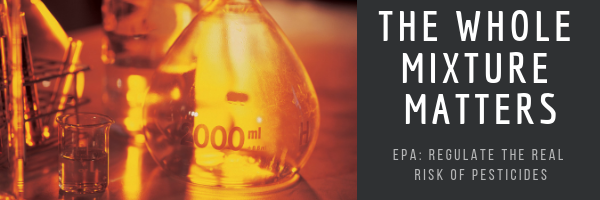15
Oct
Take Action: EPA Must Evaluate the Effects of Multiple Pesticide Ingredient Use and Exposure
 (Beyond Pesticides, October 15, 2019) EPA is requesting comment on its proposal to require data that will help it determine synergistic effects of some pesticides. EPA has received on a pressure on a number of fronts, including a report by the Center for Biological Diversity, a report by its own Inspector General, a letter from 35 Congressional Representatives, and research pointing to the unavoidability of synergistic effects—the chemical combinations that cause greater effects when mixed together than the sum of the individual chemical effects. Despite all of the evidence that synergism is the rule rather than the exception, EPA’s consideration focuses on a narrow range of cases in which pesticide product patents make claims of synergy.
(Beyond Pesticides, October 15, 2019) EPA is requesting comment on its proposal to require data that will help it determine synergistic effects of some pesticides. EPA has received on a pressure on a number of fronts, including a report by the Center for Biological Diversity, a report by its own Inspector General, a letter from 35 Congressional Representatives, and research pointing to the unavoidability of synergistic effects—the chemical combinations that cause greater effects when mixed together than the sum of the individual chemical effects. Despite all of the evidence that synergism is the rule rather than the exception, EPA’s consideration focuses on a narrow range of cases in which pesticide product patents make claims of synergy.
Tell EPA to always investigate synergy and to determine need for pesticides.
One such product is Dow’s Enlist Duo, which combines glyphosate and 2,4-D in an attempt to overcome weed resistance. The focus on products and tank mixes where synergism is a selling point brings to light the fact that as a rule, EPA does not request efficacy data in registering pesticides not intended to protect public health. Thus, although required by law to weigh pesticide risks and benefits, EPA rarely has data to make that determination.
Comment at Regulations.gov. Make the following points:
Pesticides occur in mixtures in air, soil, water, and agricultural products. The impacts of mixtures must be considered in all registration decisions.
- The decision that a pesticide does not cause unreasonable adverse effects considering all the risks and benefits requires EPA to determine whether a pesticide is effective. Therefore, efficacy data should be required for all pesticides.
- Synergistic effects of pesticides may involve interactions with pharmaceutical chemicals and naturally-occurring processes in humans and other organisms.
- Synergistic effects may be mediated in the environment. For example, an herbicide may destroy habitat for an animal that is also poisoned by an insecticide.
- EPA must investigate possible synergistic effects of all pesticides.
Written comments may be submitted through Regulations.gov until 11:59 pm ET October 24, 2019.
Not sure how to use our suggested language to comment? Follow these simple steps:
- Select the text in the bullet points above (place your cursor before the first word in the text, then press and hold down the left mouse button and, without releasing the button, move the cursor to the end of the comments).
- Copy the selected text by selecting the Ctrl and C keys simultaneously.
- Click on this link to open a new tab and in that tab, place your cursor in the “Comment” box.
- Paste the comments you copied by selecting the Ctrl and V keys simultaneously.
- Personalize your comments before entering your contact information and selecting “Continue” by adding a sentence or two about your concerns about pesticide use and/or exposure.











please investigate and research the synergistic reactions of multiple pesticides. this research is important to understand the toxic load multiple pesticides create. thanks.
October 15th, 2019 at 3:36 pmIf you have interest in chemicals and what they mean to our commercial agriculture I urge you to read Silent Spring by Dr. Carson. This book was published in the ’60’s and highlighted problems of pesticides and chemical soups that were developing around old chemical production facilities. This is still a problem and it seems the industry is purposely mixing chemical cocktails in an effort to maintain their toxicity to nature. The ‘new’ pesticides of this nature must be evaluated as they exist and are marketed. You must not evaluate a mixture of chemical based upon the ‘known’ toxicity of the individual components.
October 15th, 2019 at 7:19 pmIf you have interest in chemicals and what they mean to our commercial agriculture I urge you to read Silent Spring by Dr. Carson. This book was published in the ’60’s and highlighted problems of pesticides and chemical soups that were developing around old chemical production facilities. This is still a problem and it seems the industry is purposely mixing chemical cocktails in an effort to maintain their toxicity to nature. The ‘new’ pesticides of this nature must be evaluated as they exist and are marketed. You must not evaluate a mixture of chemical based upon the ‘known’ toxicity of the individual components.
June 11th, 2021 at 6:50 pm